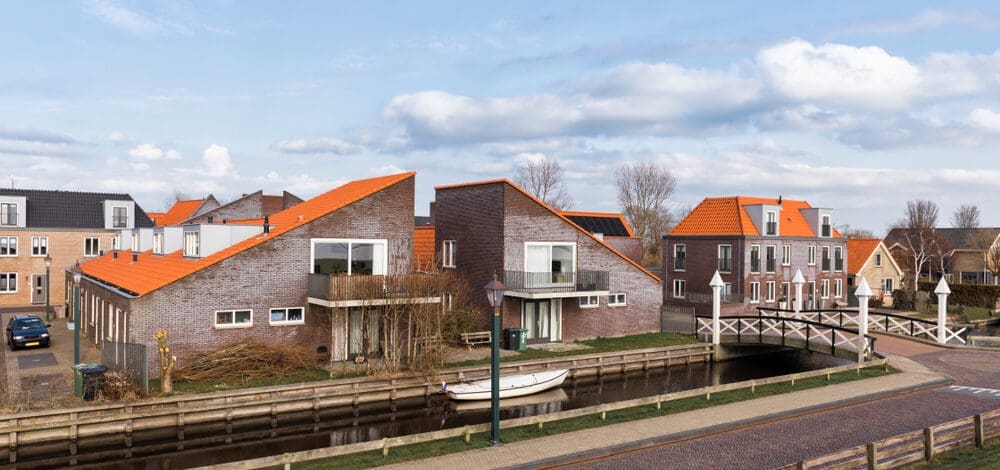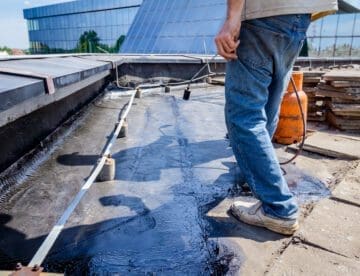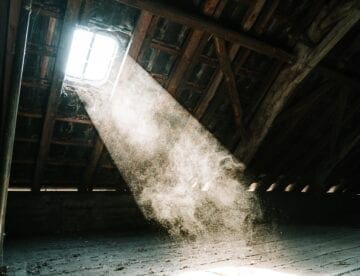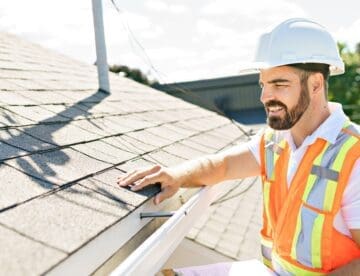When it comes to architecture, the roof is one of the most significant aspects that not only protects a building but also defines its aesthetic appeal. There are numerous roof designs to consider, each with unique features, advantages, and disadvantages. These designs have been widely adopted due to their versatility, functionality, and visual appeal. Among the myriad of designs, 10 stand out as the most common:
- Gable Roof
- Clipped Gable Roof
- Dutch Gable Roof
- Gambrel Roof
- Hip Roof
- Mansard Roof
- Shed Roof
- Jerkinhead Roof
- Bonnet Roof
- Butterfly Roof
Gable Roof Design
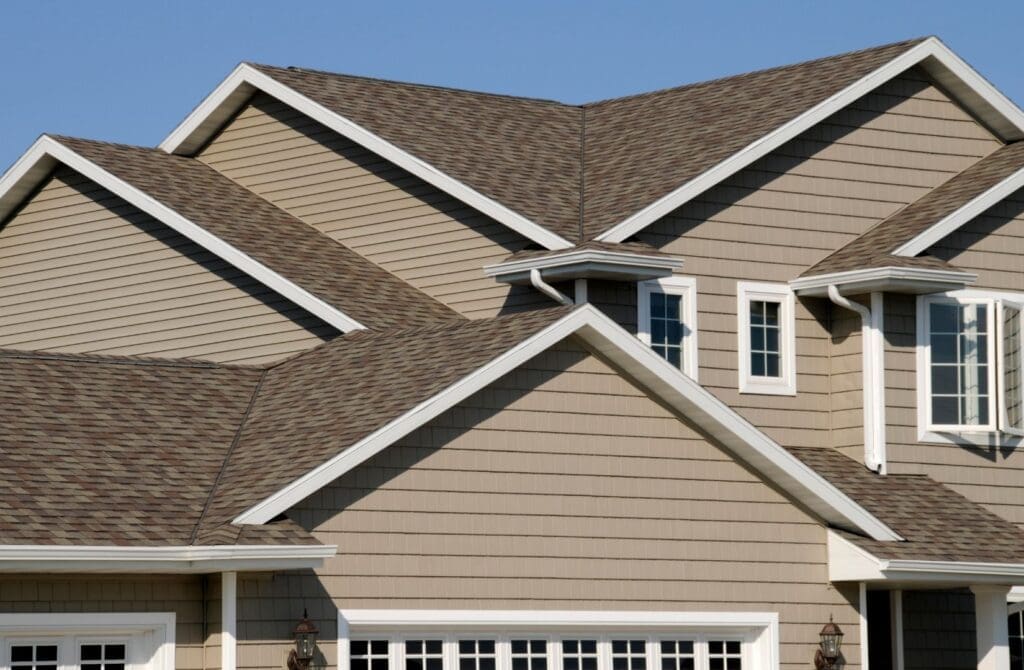
The gable roof design is one of the most popular and enduring roof styles in architecture. With its characteristic triangular shape, a gable roof is easily recognizable and widely used across various building designs.
What Does a Gable Roof Look Like?
A gable roof is defined by two sloping sides that meet at a ridge, forming end walls with a triangular extension, known as a gable. The slope of these planes can vary from house to house, but they always come together at the top to form a point. This creates the iconic triangular shape that we associate with a gable roof.
Where is a Gable Roof Used?
Gable roofs are used on many types of buildings, from residential homes to commercial structures. They are particularly common for Colonial-style homes, A-frame homes, Swiss chalets, Cape Cod houses, and Victorian-style homes. In areas prone to snow, gable roofs are often steeply pitched to allow snow to slide off and down to the ground.
Pros and Cons of Gable Roof Design
Like any architectural feature, gable roofs come with their own set of advantages and disadvantages. On the plus side, their simple design makes them relatively easy and economical to construct. They also provide good ventilation and more space for an attic or vaulted ceilings.
However, gable roofs can have some drawbacks. For instance, they tend to have a slight overhang from the face of the house, which in areas with high wind, may cause the roof to peel away.
Roofing Materials for Gable Roofs
A variety of roofing materials can be used on gable roofs, depending on the specific needs and preferences of the homeowner. These can range from traditional materials like asphalt shingles, wood shakes, and slate, to more modern options like metal and synthetic tiles. The choice of material can greatly affect the roof’s durability, maintenance requirements, and aesthetic appeal.
Gable roofs are a versatile and popular choice in architecture, offering a balance of practicality, economy, and aesthetic appeal. However, like any design, they must be carefully planned and executed to ensure safety and longevity.
Clipped Gable Roof Design

The clipped gable roof design, also known as a jerkinhead or hipped gable roof, is a unique and visually intriguing style that combines elements of both gable and hip roof designs.
What Does a Clipped Gable Roof Look Like?
A clipped gable roof is characterized by its flattened top. Instead of the two roof sections meeting at a point, the peak is “clipped off,” and appears to slope downward. This gives the roof a somewhat boxy appearance, with a triangular section extending beyond the main body of the building.
Where is a Clipped Gable Roof Used?
Clipped gable roofs can be found on a variety of building types, from residential homes to commercial structures. They are particularly popular in Craftsman and bungalow-style homes, where they add traditional curb appeal and architectural interest.
Pros and Cons of Clipped Gable Roof Design
The clipped gable roof design offers several advantages. Its unique shape not only adds visual appeal but also has practical benefits. The clipped gable helps to reduce wind force on the building’s facades, making it a good choice in areas prone to high winds. The shorter slope of the clipped gable also helps to shed water more effectively than a standard gable roof, reducing the risk of water infiltration and damage.
However, like any roof design, the clipped gable comes with its own set of drawbacks. For instance, the construction process can be more complex and costly than for a standard gable roof due to the additional framing required.
Roofing Materials for Clipped Gable Roofs
A variety of roofing materials can be used on clipped gable roofs, depending on the specific needs and aesthetic preferences of the homeowner. These can range from traditional materials like asphalt shingles, wood shakes, and slate, to modern options like metal panels and synthetic tiles.
While the clipped gable roof design may require more complex construction, its distinctive appearance, and practical benefits make it a popular choice for many homeowners.
Dutch Gable Roof Design
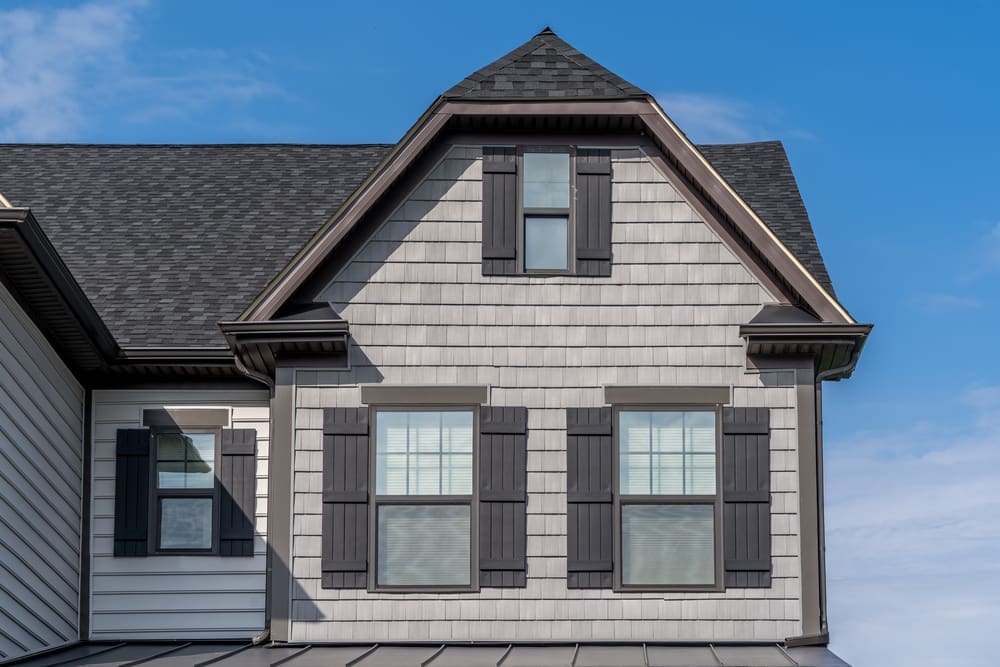
The Dutch gable roof design, known for its unique blend of traditional hip and gable roof styles, creates a striking aesthetic while offering functional benefits.
What Does a Dutch Gable Roof Look Like?
A Dutch gable roof combines the elements of a hip roof, which has four sloping sides, with a gable roof placed at the top, often referred to as a “gablet”. This design results in a roof that has the basic structure of a hip roof but includes a small triangular gable at the peak. Some Dutch gable roofs also feature flared eaves for additional architectural interest.
Where is a Dutch Gable Roof Used?
Dutch gable roofs are versatile and can be found on various types of buildings, from residential homes to commercial structures. They are particularly popular in regions where traditional architectural styles are favored, adding an element of charm and visual interest.
Pros and Cons of Dutch Gable Roof Design
Dutch gable roofs offer several advantages. The main benefit is that they combine the strengths of both gable and hip roofs. The gable portion allows more natural sunlight to enter the space, potentially reducing heating bills in the winter. It also provides additional storage space and the possibility of adding a window for extra ventilation and light.
However, Dutch gable roofs also have certain drawbacks. Their structural complexity, especially depending on the size of the gablet and the intended use of that space, can make construction more complex and costly. More materials are needed to build the roof, and strong supports must be put in place.
Roofing Materials for Dutch Gable Roofs
A wide range of roofing materials can be used on Dutch gable roofs, just like with other roof designs. These include traditional materials like asphalt shingles, wood shakes, and slate, as well as modern options like metal panels and synthetic tiles.
While the Dutch gable roof design may require more complex construction, its unique appearance, and practical benefits make it a popular choice for many homeowners.
Gambrel Roof

The gambrel roof design, known for its distinctive silhouette and practical features, has been a staple in architecture for centuries.
What Does a Gambrel Roof Look Like?
A gambrel roof is characterized by two symmetrical sides, with each side featuring two slopes of different angles. The upper slope is less steep than the lower one, creating a unique profile that is easily recognizable. This design gives the roof a barn-like appearance, which is why it’s often referred to as a barn roof.
Where is a Gambrel Roof Used?
Gambrel roofs are widely used in various types of buildings, from residential homes to commercial structures. They’re particularly common on barns, sheds, and farmhouses, but can also be found on Dutch Colonial and Georgian-style homes.
Pros and Cons of Gambrel Roof Design
Gambrel roofs offer several advantages. First, their design allows for additional living or storage space under the roof, often used for attics or loft areas. Furthermore, due to their straightforward design, gambrel roofs can be more cost-effective to build than other roof designs.
However, gambrel roofs also have some drawbacks. Their open design can make them more susceptible to wind damage and collapse. Additionally, they may not be ideal for areas that receive heavy snowfall, as the weight of the snow can put significant strain on the roof.
Roofing Materials for Gambrel Roofs
A wide variety of roofing materials can be used on gambrel roofs, depending on the specific needs and aesthetic preferences of the homeowner. These can include traditional materials like asphalt shingles, wood shakes, and slate, as well as modern materials like metal panels and synthetic tiles.
The gambrel roof design offers a unique blend of aesthetic appeal and functional benefits, making it a popular choice for many types of buildings.
Hip Roof
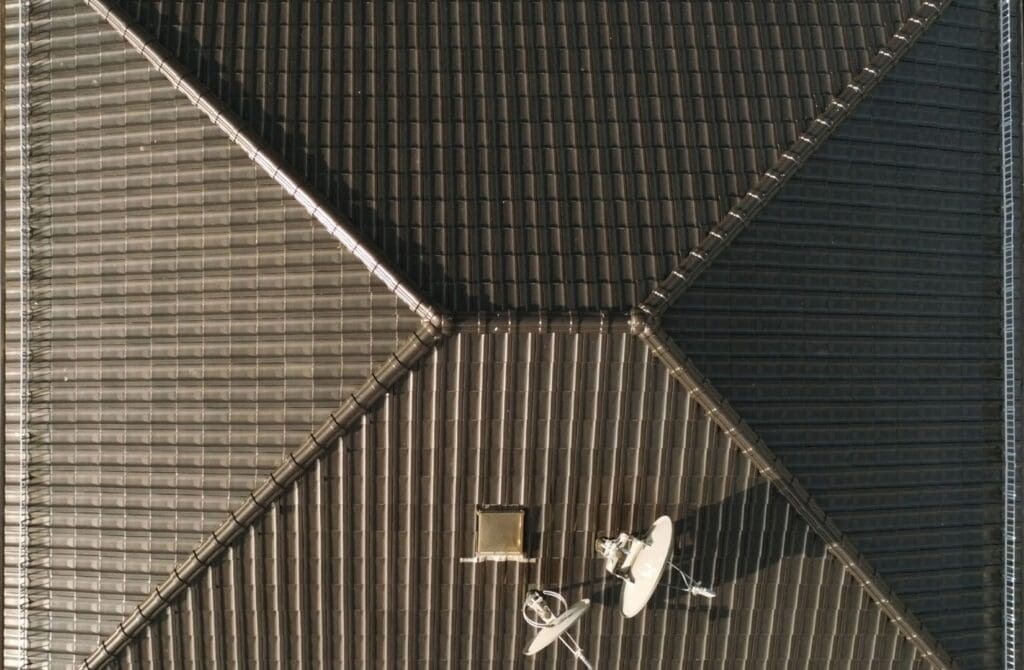
The hip roof design, with its characteristic sloping on all sides, is a popular choice for homeowners looking for structural stability and aesthetic appeal.
What Does a Hip Roof Look Like?
A hip roof is characterized by all four sides sloping downwards to meet the walls. There are no vertical or flat sides, as there would be with a gable roof. The slopes of a hip roof are usually at the same angle, creating a symmetrical, balanced look.
Where is a Hip Roof Used?
Hip roofs are versatile and can be found on various types of buildings, from residential homes to commercial structures. They’re particularly common in regions prone to hurricanes or high winds, due to their strong and sturdy design.
Pros and Cons of Hip Roof Design
Hip roofs offer several advantages. Their four-way slope makes them more stable than other roofing types, allowing water and snow to run off with ease. This design also provides more ventilation and space for an attic, adding to the functional benefits of this roof style.
However, hip roofs also have some drawbacks. They’re more complex to construct, which can lead to higher costs. Furthermore, they offer less internal roof space than gable roofs, which could be a disadvantage if you’re looking to maximize storage or living space.
Roofing Materials for Hip Roofs
Various roofing materials can be used on hip roofs, depending on the specific needs and aesthetic preferences of the homeowner. These can range from traditional materials like asphalt shingles, wood shakes, and slate, to modern materials like metal panels and synthetic tiles.
While the hip roof design may require more complex construction, its unique appearance, and practical benefits make it a popular choice for many types of buildings.
Mansard Roof
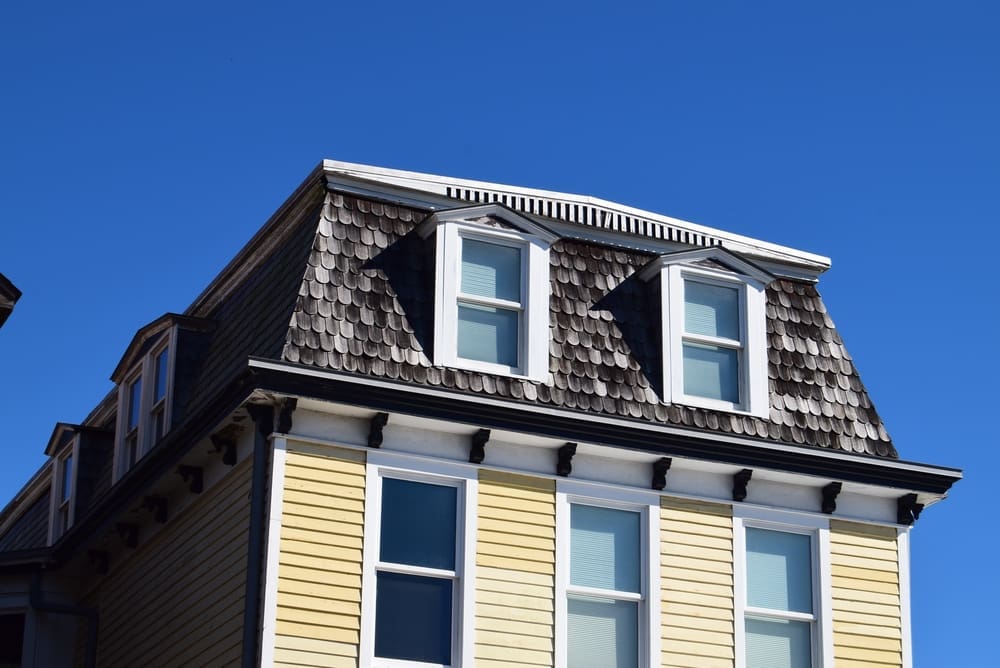
The Mansard roof, also known as the French or curb roof, is a distinctive architectural feature characterized by its double-sloped sides and unique sense of style.
What Does a Mansard Roof Look Like?
A Mansard roof is easily identifiable by its two slopes on each side, with the lower slope being steeper than the upper one. This design often features dormer windows punctuating the lower, steeper slope, adding an extra touch of character.
Where is a Mansard Roof Used?
The Mansard roof was widely used in Renaissance and Baroque French architecture and has since been incorporated into various types of buildings, from residential homes to commercial structures. Its unique design allows for better utilization of interior space, often providing an extra livable floor within what would typically be the attic.
Pros and Cons of Mansard Roof Design
The Mansard roof offers several advantages, the main one being the additional living space it provides. This design turns an otherwise unusable attic space into an extra floor, while the dormer windows let in an abundance of light.
However, Mansard roofs also have their drawbacks. They require more framing labor and materials, making the installation cost higher than the average roof. Additionally, the low pitch of the upper slope may not provide adequate runoff in areas with heavy rain or snow, potentially leading to water damage.
Roofing Materials for Mansard Roofs
A variety of roofing materials can be used on Mansard roofs, depending on the specific needs and aesthetic preferences of the homeowner. These can range from traditional materials like asphalt shingles, wood shakes, and slate, to more modern options like metal panels and synthetic tiles.
While the Mansard roof design may require more complex construction, its unique appearance, and practical benefits make it a popular choice for many buildings.
Shed Roof
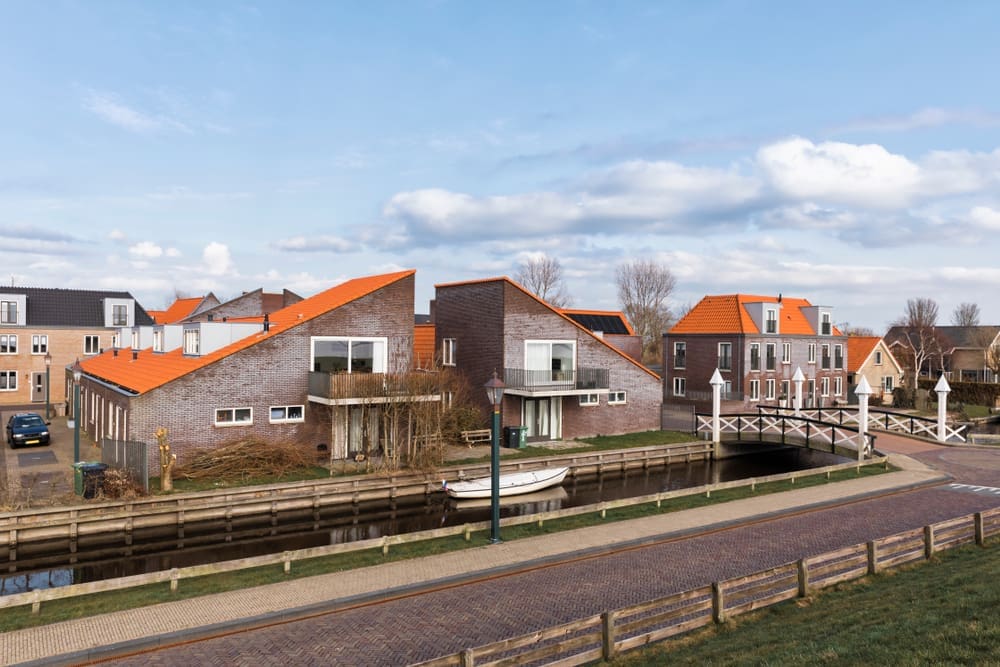
The shed roof design, also known as a skillion roof, is characterized by its simplicity and functionality.
What Does a Shed Roof Look Like?
A shed roof is distinguished by a single sloping side, creating a simple, clean, and modern look. This unique design allows for easy water runoff and can be easily recognized due to its straightforward design.
Where is a Shed Roof Used?
Shed roofs are commonly used on actual sheds, but their usage extends beyond that. They are found on various types of buildings, from residential homes to commercial structures, particularly those with a modern architectural style.
Pros and Cons of Shed Roof Design
Shed roofs have several advantages. They are easy to build and inexpensive compared to more complex roof designs. Their slope provides good drainage, reducing the risk of water damage.
However, they also have some drawbacks. Shed roofs may not stand up well to high wind conditions and may not fit the style of every type of home. Additionally, while their simplicity can be an advantage, it can also limit the architectural interest of the building.
Roofing Materials for Shed Roofs
Various roofing materials can be used on shed roofs, depending on the specific needs and aesthetic preferences of the homeowner. One of the most popular options is bitumen roof sheets, which are suitable for a wide range of shed roofing types and garden designs. These corrugated sheets are versatile and great for both Apex and lean-to sheds. Other materials that can be used include traditional materials like asphalt shingles, wood shakes, and slate, as well as more modern materials like metal panels and synthetic tiles.
While the shed roof design may be simple, its practical benefits make it a popular choice for many buildings.
Jerkinhead Roof
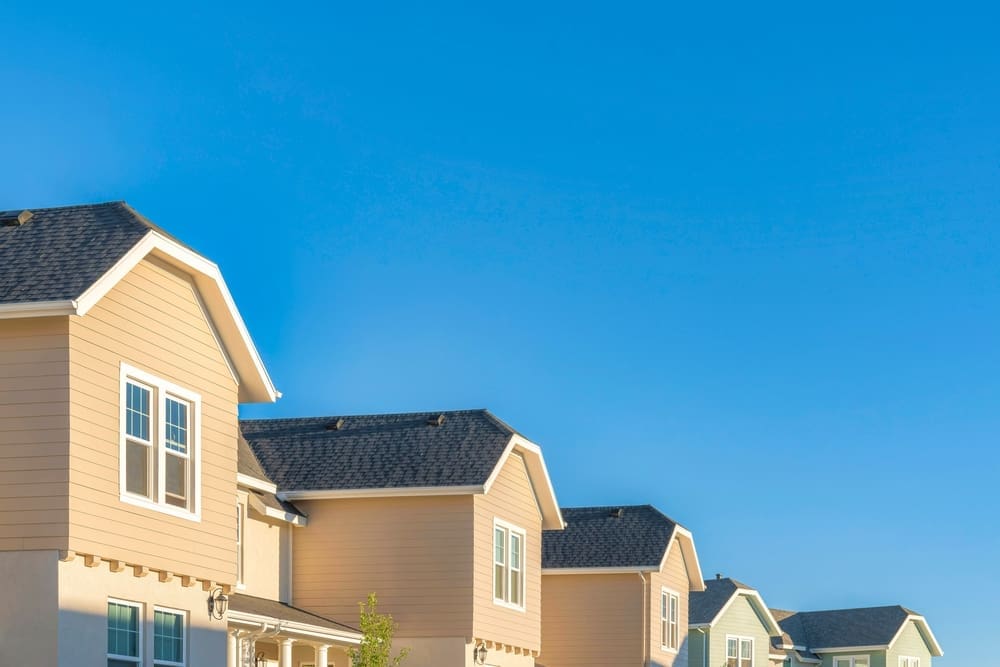
The Jerkinhead roof, also known as a clipped gable or half-hip roof, is a hybrid design that combines elements of the gable and hip roof styles.
What Does a Jerkinhead Roof Look Like?
A Jerkinhead roof features a gable roof design with two sloping sides. However, the ends of the roof have hipped sections that are clipped short, giving it a unique appearance. This design results in a roof that shares characteristics with both gable and hipped roofs.
Where is a Jerkinhead Roof Used?
Jerkinhead roofs can be found on various types of buildings, from residential homes to commercial structures. Architectural styles where a Jerkinhead roof is most prevalent include stick style, bungalows, Queen Anne, Tudor, and English country.
Pros and Cons of Jerkinhead Roof Design
Jerkinhead roofs offer several advantages. They combine not just the appearance, but also the physical strength of both gable and hipped roofs. The system of trusses and supports used in their construction can withstand high winds and heavy snow loads better than a standard gable roof.
However, Jerkinhead roofs also have some drawbacks. Their design can be more complex and therefore more expensive to construct than simpler roof styles. Furthermore, their unique shape may require custom-made materials, which could add to the overall cost.
Roofing Materials for Jerkinhead Roofs
Various roofing materials can be used on Jerkinhead roofs, depending on the specific needs and aesthetic preferences of the homeowner. These can range from traditional materials like asphalt shingles, tiles, and metal panels, to more modern options like synthetic materials.
The Jerkinhead roof design offers a unique blend of aesthetic appeal and structural strength, making it a popular choice for many types of buildings.
Bonnet Roof

The bonnet roof, a unique blend of hip and mansard roofs, is a design that combines functionality with aesthetic appeal.
What Does a Bonnet Roof Look Like?
A bonnet roof is characterized by its extension past a home’s walls on all sides. It’s essentially a hip roof with an overhang that provides shade. Unlike a standard mansard roof where the lower slope is steeper, a bonnet roof features a steeper upper slope and a less steep lower one.
Where is a Bonnet Roof Used?
Bonnet roofs are ideal for homes with outdoor patios or wrap-around porches, as the overhang provides ample shade. They are often used on narrow, steep, and flat buildings, but may not be suitable for wider, flatter structures.
Pros and Cons of Bonnet Roof Design
The benefits of a bonnet roof include its structural soundness, protection for a home’s siding, and promotion of optimal water drainage. Moreover, the design offers great shade and protection, making it a top pick for homes with outdoor spaces.
However, bonnet roofs have their drawbacks. They can be more complex to construct than simpler roof styles, potentially leading to higher costs. Their unique shape may also require custom-made materials, which could add to the overall cost.
Roofing Materials for Bonnet Roofs
Various roofing materials can be used on bonnet roofs, depending on the specific needs and aesthetic preferences of the homeowner. These can range from corrugated steel panels and plastic roofing for pre-engineered buildings to traditional materials like asphalt shingles, tiles, and metal panels.
The bonnet roof design might require more complex construction, its unique appearance and practical benefits make it a popular choice for many buildings.
Butterfly Roof

The butterfly roof, known for its distinctive V-shape resembling two lifted wings, is a design that combines aesthetic appeal with environmental efficiency.
What Does a Butterfly Roof Look Like?
A butterfly roof is characterized by an inversion of a standard roof form, with two roof surfaces sloping down from opposing edges to a valley near the middle of the roof. This unique design allows for rainwater collection and improved natural light within the building.
Where is a Butterfly Roof Used?
Butterfly roofs can be found on various types of buildings, from residential homes to commercial structures. They are particularly popular in modern and mid-century modern architecture. The design also finds use as a standalone structural system in diverse typologies ranging from independent houses to bus stop sheds.
Pros and Cons of Butterfly Roof Design
Butterfly roofs offer several advantages. They are aesthetically striking, make for efficient rainwater collection systems, and allow for increased natural light within the building.
However, butterfly roofs also have their drawbacks. They are more costly to build and install than a standard gable roof. Furthermore, they are not recommended for areas with heavy water and snowfall, as the accumulation of debris could potentially result in roof damage or even collapse.
Roofing Materials for Butterfly Roofs
Various roofing materials can be used on butterfly roofs, depending on the specific needs and aesthetic preferences of the homeowner. These can range from traditional materials like asphalt shingles, wooden shakes, and slate, to other options like concrete, steel truss, fiber, asbestos cement sheet, and galvanized iron sheet.
While the butterfly roof design may require more complex construction, its unique appearance, and practical benefits make it a popular choice for many buildings.
Choosing the Right Roof Design
Deciding on the right roof design for your home or building is a critical decision that affects not only the aesthetic appeal but also the functionality and longevity of the structure. Factors such as climate, architectural style, budget, and personal preference all play a role in determining the most suitable roof type. The roofing material also significantly contributes to the roof’s durability, maintenance requirements, and overall cost, with options ranging from tar and gravel, roll roofing, metal sheets, PVC, TPO, and rubber membrane.
Ultimately, choosing the right roof involves a careful balance of aesthetic preferences, practical considerations, and budget constraints. It’s always advisable to consult with a professional roofer or architect to ensure that the chosen roof design and material will meet your needs and stand the test of time.
About Code Engineered Systems
Code Engineered Systems is a family owned & operated roofing company in Tampa. We provide both residential roofing and commercial roofing services and have decades of experience in roof replacements and roof repairs on all types of roofing systems including asphalt shingle roofs, tile roofs, metal roofs, and all types of flat roofs. Our roofing company is owned and managed by Russell Dodson and Tim Hutchinson who together have a combined experience of over 70 years in the roofing industry building a strong reputation roofing in Tampa since the 1970’s. Russell has spent nearly 30 years mostly in the commercial side of the roofing industry while Tim started his roofing career back in 1976 primarily working in the residential side of the roofing industry.
Our reputation in the roofing industry in the Tampa Bay area is extremely important to us. We understand that providing consistent professional and quality roofing work & customer service is the key to the long-term success of our family roofing company in Tampa. We rely heavily on word of mouth and customer referrals as the most effective form of advertising and consider every single roof replacement or roof repair we do as an investment in our company’s reputation. We have always felt honored when our customers choose us for their roofing needs and are dedicated to returning the favor by providing the best experience possible including being there for them long after the job has been completed and paid for. With decades of roofing experience and thousands of roofing jobs completed all over the Tampa Bay Area, you can feel confident that you are hiring highly experienced roofing professionals who care. If you would like to schedule your free roof estimate please give us a call at 813-373-9088 or fill out our FREE ESTIMATE FORM.
We provide roofing services for all of Hillsborough County & Pinellas County, including Tampa, Riverview, Apollo Beach, Brandon, Plant City, St. Petersburg, Largo, & Clearwater.

